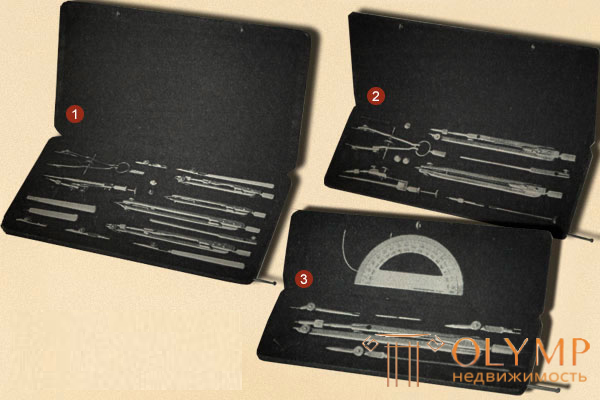
Tools and devices used in the technique of linear graphics can be divided into three groups.
The first group of tools for linear graphics includes the most primitive in terms of design, reliable and effective in terms of the results of using the device - pencils (ordinary and automatic), coal sticks, feathers and brushes. The change in the inclination of the tool, the force of its pressure, the use of paper smooth or textured allows you to draw lines of different thickness, curvature and texture. The author of the image uses a primitive tool as a continuation of his own hand. At the same time, the skills of graphics-specific movements of the entire arm, elbow joint, hand, fingers, which control the instrument, are formed. The complex complex of these movements, which give freedom of image in combination with a developed imagination and taste, is graphic skill.
Tools and devices used in the technique of linear graphics can be divided into three groups.
The first group of tools for linear graphics includes the most primitive in terms of design, reliable and effective in terms of the results of using the device - pencils (ordinary and automatic), coal sticks, feathers and brushes. The change in the inclination of the tool, the force of its pressure, the use of paper smooth or textured allows you to draw lines of different thickness, curvature and texture. The author of the image uses a primitive tool as a continuation of his own hand. At the same time, the skills of graphics-specific movements of the entire arm, elbow joint, hand, fingers, which control the instrument, are formed. The complex complex of these movements, which give freedom of image in combination with a developed imagination and taste, is graphic skill.
The following modern tools are referred to the second group of tools for linear graphics: graphos (recording pen with feather and tubular nozzles); felt-tip pen (a bottle of printing ink that feeds the felt tip); Rapidographer (self-recording pen with tubular needle heads); automatic pencil with retractable thin leads; Reisfeder (drawing tool with adjustable screw width of the divorce of the blades of a metal pen). All these tools are adapted to image lines of the same thickness. Only an experienced schedule, manipulating the felt-felt felt pen or rapid-needle needle under different inclinations and with different pressures, can make a line of varying thickness. As a rule, all the named tools (except for the felt-tip pen) are intended for drawing (Fig. 3-5). In addition, a distinctive feature of the named group of tools (except for mechanical pencils) is the impossibility of correcting them. To correct the lines, it is required to cut the image from the paper or to close the incorrectly drawn line with a layer of white. This feature forces the graphics to work with increased attention, to clearly control themselves, since any inaccuracy leads to a distortion of the drawing, reducing the quality of the drawing.
Circular curves are drawn using compasses of various sizes and devices. A set of compasses, gauges, redefeper and various nozzles is called more readily. Modern workers have special tools that allow them to draw curves, both with the help of reydeperov, and with the help of the rapid gauge tips. There are ready, completed with various nozzles of graphos (Fig. 1).

1. Ready design large; 2. Ready special; 3. Preparatory school
Fig. 1. Different types of ready
Mastering the skills of using the fisheder, felt-tip pen, graphos, rapidograph, fine automatic pencil micrograph is advisable after mastering the technique of using an ordinary pencil, pen, fine brush, and coal. In the case of premature acquaintance with the work of a rapidographer, a felt-tip pen, an inexperienced person shackles his graphic skills, the style of his graphics becomes dry, primitive. This is explained by the fact that an inexperienced draftsman, using a line of one thickness in a drawing, drawing, thereby condemns himself to expressing his creative ideas with the help of very expressive means. As a result, a rough drawing or drawing style is developed, devoid of flexibility and precision in the use of a wide range of linear graphics tools.
The third group includes devices with the help of which linear graphics is modeled from ready-made elements. These devices include letraset, special stencils and templates.
Letraset - the image of lines, various textures, fonts, details of surroundings and equipment, applied on sheets of transparent paper by the method of decal. The use of letraset saves time, reports the drawing clarity, clarity, universality of perception of the symbolism of graphic information. However, the specialist who applies the letraset depends entirely on the quality of the linear pattern reproduced in the industrial design.
Stencils - sheets of thick plastic, plastic films with cut out contours of various images, circles, ellipses, etc. The use of stencils is advisable only when working on graphic drawings, where the character of the graphics should be extremely informative with the extensive use of conventional symbols, a special style of coarse linear graphics relatively thick lines.
The skills of compositional work acquired in the initial stages of training in the process of drawing, drawing with the use of various simple tools, are shaped into a certain culture. These skills later, at senior courses, contribute to the competent, conscious use of letrasets, stencils, templates.
Что бы оставить комментарий войдите
Комментарии (0)